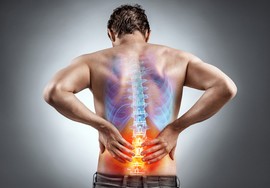Handling Aches & Pains
Chronic pain is one of the leading conditions that primary healthcare professionals encounter in their practice, particularly in patients over the age of 65. Chronic pain in the older population is associated with a variety of negative effects, including substantial disability due to reduced mobility, avoidance of physical activity, falls, disturbed sleep, depression and anxiety, as well as social isolation. The negative effects of chronic pain in the older population extend beyond the individual patient, affecting both family relationships and friendships. Chronic pain also places an enormous burden on society.
 Aches and pain happen with aging because the ligaments and tendons that hold your joints in place can become stiff or start to accumulate wear and tear. In addition to this, the prevalence of osteoarthritis increases with aging, with 30 to 50% of adults over the age of 65 years suffering with this condition. These two factors can result in the joint cartilage wearing away and lead to aching, soreness, and pain. The good news is that you can help to minimize aches and pains by conditioning your body by engaging in flexibility, cardiovascular, and strength training exercises.
Aches and pain happen with aging because the ligaments and tendons that hold your joints in place can become stiff or start to accumulate wear and tear. In addition to this, the prevalence of osteoarthritis increases with aging, with 30 to 50% of adults over the age of 65 years suffering with this condition. These two factors can result in the joint cartilage wearing away and lead to aching, soreness, and pain. The good news is that you can help to minimize aches and pains by conditioning your body by engaging in flexibility, cardiovascular, and strength training exercises.
Stretching is vital to minimize aches and pains as you age because it helps to maintain, and can even improve, the pliability and responsiveness of the ligaments and tendons that support the joints of your body. Extra weight that you carry as you get older can contribute to aches and pain because it stresses the joints of your body, particularly combined with overall decreasing muscle mass.
Cardiovascular exercise and strength training, combined with a nutritious and balanced diet, is the best way to maintain a healthy weight. Strength training, especially strengthening your core and legs, can help to minimize aches and pains in your back. Further, strengthening other areas of your body helps to decrease aches and pain because by strengthening the muscles that cross the joints you improve the support and stability of the joint, thereby leaving them less susceptible to injury and pain. Strong muscles also help with improving or maintaining good posture which helps to ensure you aren’t abnormally or excessively loading your joints. Exercise particularly helps to lubricate the joints and increase blood flow and nutrition to all the supporting structures. Motion is lotion!
If at first, you’re unable to tolerate flexibility, cardiovascular or strength training, and the pain starts to significantly interfere with your life, there are a variety of therapies that have been shown to help reduce pain and anxiety, and improve function. These passive therapies include acupuncture, massage, and transcutaneous nerve stimulation. These treatments are a good way to get started as they allow you to move with less pain, and thereby allow you to exercise. Passive therapy won’t get you long term results or improve your resilience but they can offer short term relief to get you going. Additionally, assistive devices such as canes, walkers, and braces can help to control pain by altering the load to the joints, provided that they are used correctly. Meeting with a physiotherapist can help to ensure that you’re taking advantage of all of the therapies available to help manage your symptoms.
If you want to learn how to manage aches and pain as you get older, you may benefit from physiotherapy. A physiotherapist will assess your muscles, joints, and nervous system, look at how you move, and explore your work and leisure activities to determine possible causes of your pain. Individual treatment will often entail hands-on work to the affected body structures, as well as education and rehabilitative exercise to keep you pain and injury free.
Undergoing a comprehensive evaluation by a physiotherapists at North Hill Physiotherapy is one of the best ways to gain an understanding of how you can enhance the health of your body. After the assessment, our physiotherapists will create a program that is specific to your needs, which will help to manage any aches and pains you may be suffering from as you age.
References
1. Reid M, Eccleston C, Pillemer K. Management of chronic pain in older adults. BMJ. 2015;350(feb13 2):h532-h532. doi:10.1136/bmj.h532.
2. How to Beat the Pain of Aging. WebMD. 2018. Available at: https://www.webmd.com/men/features/aging-real-pain-neck#1. Accessed January 7, 2018.
3. Loeser R. Age-Related Changes in the Musculoskeletal System and the Development of Osteoarthritis. Clinics in Geriatric Medicine. 2010;26(3):371-386. doi:10.1016/j.cger.2010.03.002.
4. Guidance on the management of pain in older people. Age and Ageing. 2013;42(suppl 1):i1-i57. doi:10.1093/ageing/afs200
